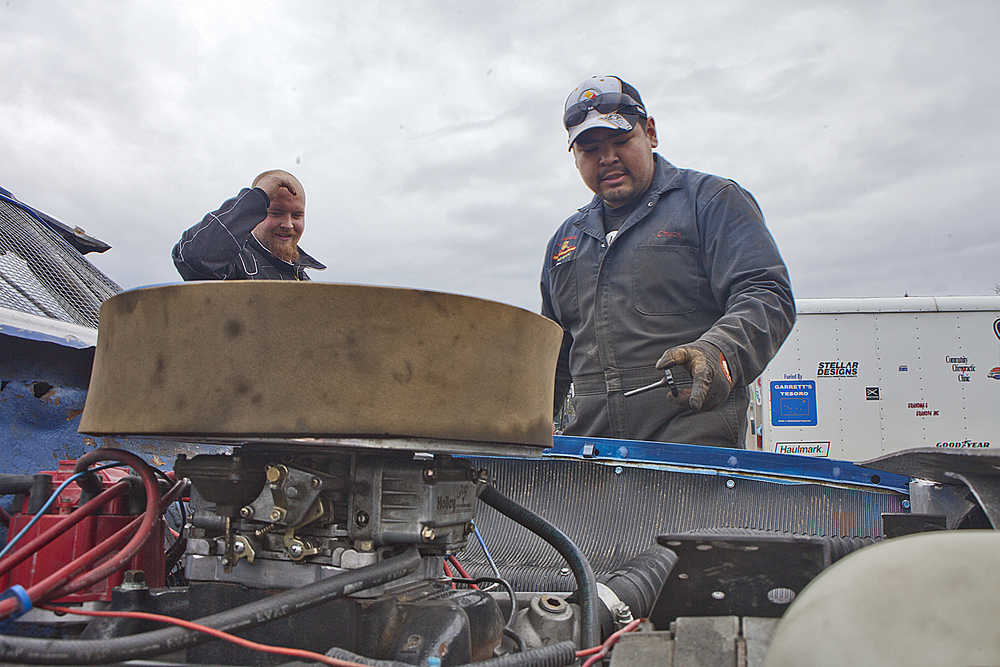Eyes gritted against the billowing dust, Keith Jones pushed his cellphone closer to his ear and raised his voice to be heard over the throaty rumble rising from the souped-up engines of cars waiting for a chance at the dirt track at Twin City Raceway in Kenai.
At the other end of the line, Jones’ 17-year-old daughter rounded a turn and then punched the gas on her modified 1983 Monte Carlo, kicking up a fresh cloud of dirt and accelerating quickly down the straightaway before Jones told her to ease off of the gas just in time to round a corner into the next turn.
About 50 feet away, Jeremy Echuck pulled a plug from Mike Eyre’s Monte Carlo to check fluid levels after Eyre’s run on the track.
The Saturday before opening weekend at Twin City Raceway, 15 drivers and dozens of spectators and pit crew showed up for Test & Tune — the last chance many of them will get to iron out the kinks in their cars before the summer’s racing season.
Each driver had the chance to take several solo runs around the track, with no other cars in sight, to check out how their cars held up over the winter or handled new modifications.
Pit crew, like Echuck, were on standby to fix problems that sprung from overheating or forgetting to tighten engine components — or from cars just going to long without being driven.
“I just make sure it runs nice and has no leaks and make sure nothing goes kaput when it gets to operating temperature,” Echuck said as he worked on Eyre’s car.
For Keith Jones and his daughter Ashten Jones, most of their time was spent on the phone with Ashten on the track learning the line that her father wanted her to run.
“When she gets comfortable in that line around the track, then we can start picking up some speed,” he said.
The two were derailed briefly when Ashten Jones pulled the car up to the track entrance and left puddles of pink-tinged transmission fluid on the ground. Keith Jones noticed the fluid running down the car’s front bumper and signaled to her to turn back from the track and park it near the family’s trailer.
He located the trouble quickly — a blown transmission line — and filled the car back up with fluid after repairing the line.
“I’ll send her back out,” he said. “I want her to make as many laps as she can today.”
The Joneses weren’t the only ones discovering mechanical issues with their cars.
Last year’s late model racing champion, Mike Braddock, lost his brakes while making a run on the track. The culprit, he determined, was the loose dust that race organizers had struggled to keep wet throughout the day.
“The track conditions are not ideal and dirt built up around the caliper and the brakes failed,” he said.
After Braddock’s car limped off the track and over to a trailer for repair, he pointed toward the pile of dirt that had fallen from rear brakes after the tire had been removed.
Nearby, Twin City Raceway President Johna Beech looked on as Braddock picked up a handful of the semi-damp dirt.
The two examined the pile as Beech explained that race organizers would be wetting and grading the track repeatedly until it formed a clay-like compound that was easier to race on than the loose dirt.
“We’ve gotten a lot of advice on how to make the track a better track,” she said.
One of those changes will be the introduction of sawdust into the dirt on the track to help the dirt bind better, she said.
Braddock, of Palmer, and the Joneses of Wasilla, regularly make the trek to Kenai to race on the dirt track.
Despite the snag, Braddock was unfazed.
“It’s my first time on the track this year,” he said. “There’s going to be a lot of bugs. Conditions are not ideal, it’s going to happen from time to time.”
Reach Rashah McChesney at rashah.mcchesney@peninsulaclarion.com.

